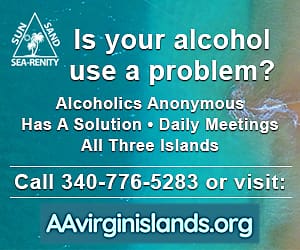
The National Weather Service (NWS) in San Juan, Puerto Rico, has warned that hot temperatures will continue for several days across portions of the U.S. Virgin Islands and Puerto Rico. Limited amounts of Saharan dust may also be present in the atmosphere.
“Hot and humid conditions will continue, with an elevated-to-significant [level of] heat risk, particularly across lower elevations of the islands, according to an update on Monday from the NWS. “The aerosol [computer forecast] models [which predict particles in the air] also indicate slight concentrations of Saharan dust in the area, so skies may look gray and hazy at times today through Wednesday,” the NWS continued.
An area of high pressure over the islands, combined with a mass of dry air, has contributed to the elevated temperatures. The NWS explained that the high level of heat can be dangerous, especially for individuals without access to air conditioning.
“This level of heat affects anyone without effective cooling or adequate hydration. Impacts [are] likely [to occur] in some health systems, heat-sensitive industries, and infrastructure,” the NWS explained.
Regarding the possible effects on infrastructure, electrical outages may be possible due to surging power demand during hot weather. A recent Source article explained why the Virgin Islands Water and Power Authority implemented fuel conservation measures at the beginning of September—including WAPA’s scheduled rotating power outages—to mitigate the use of fuel resources during periods of high demand for electricity to power items such as air conditioners.
According to the NWS, temperatures are forecast to exceed 90 degrees Fahrenheit across the U.S. Virgin Islands on Tuesday, and a high heat index means that it will feel even hotter. The NWS defines the heat index as “what the temperature feels like to the human body when relative humidity is combined with the air temperature.”
Heat Advisories and Warnings
The NWS in San Juan, Puerto Rico, has regularly issued Heat Advisories and Heat Warnings for portions of Puerto Rico and the U.S. Virgin Islands over the last few months, and alerts were issued for both the USVI and Puerto Rico again on Monday. The notifications provide residents and visitors with information about where the warmest temperatures are forecast to occur and the heat-related illnesses that may occur due to hot weather.
“Residents and visitors should take precautions to stay hydrated by drinking plenty of water, wearing light and breathable clothing, and avoiding prolonged exposure to the sun, especially during peak heat hours,” the NWS advised.
The Source contacted Manuel Ramos-Rodriguez, a meteorologist at the NWS office in San Juan, Puerto Rico, for additional information on the current weather situation and how long the hot temperatures may continue. Ramos-Rodriguez said that there’s a chance that the heat may subside later in the week.
“On Thursday, we expect more northeasterly winds, precipitable water somewhat increasing, [there will be higher amounts of moisture in the atmosphere resulting in the possibility of increased chances of rain,] and the upper-level high pressure now affecting us [will start] to break [allowing for a change in the weather pattern],” Ramos-Rodriguez stated.
“[Therefore,] we could see relief for the second half of the workweek. [However,] at least [some] limited heat risks will remain, unfortunately,” Ramos-Rodriguez added.
Health Department Tips
According to information reported in a previously published Source article, Dr. Tai Hunte-Ceasar, chief medical officer of the V.I. Health Department spoke to the Source and offered suggestions for how residents and visitors across the USVI can remain safe and healthy during extreme heat.
“The V.I. Department of Health continues to monitor weather conditions, especially as we continue to be impacted by more frequent heat waves and excessive heat due to climate change,” Hunte-Ceasar said.
“We are most concerned with our seniors 65 and older, who are the most vulnerable to heat strokes and heat illnesses,” Hunte-Ceasar explained. “We continue to encourage our seniors and everyone to drink water, stay hydrated, and keep cool as much as possible,” she added.
“Besides our elderly, vulnerable populations include children and infants, construction workers or others who work outside or in the direct sunlight for extended hours, persons living with disabilities, and persons with chronic heart and lung conditions, especially those requiring oxygen,” Hunte-Ceasar noted.
Hunte-Ceasar cited heat-related health problems that can arise from hot weather. “Illness from heat-related illness can happen within minutes to hours of exposure, and they vary on a spectrum:
- Heat Rash: A red cluster of blisters that look like small pimples.
- Sunburn: Painful, red, and warm skin [with possible] blisters that eventually lead to skin peeling.
- Heat Cramps: [This condition causes] heavy sweating during intense exercise, muscle pain, or spasms.
- Heat Exhaustion: Heavy sweating, cold and clammy skin, nausea/vomiting, muscle cramps, weakness, fatigue, dizziness, headache, fainting.
- Heat Stroke: Fever; hot, red, dry, or damp skin; headache, dizziness, nausea, confusion, [and] passing out.”
To help avoid falling ill due to hot temperatures, Hunte-Ceasar offered the following advice:
- “Avoid being outdoors in the direct sun during the highest sun peak hours between 11 a.m. and 1 p.m.
- Use air conditioning or fans to keep your environment cool.
- If you are sweating, replace minerals with sports drinks, such as Gatorade.
- Wear cool clothing.
- Wear sunscreen if you are in the sun.
- Avoid hot and heavy meals during the hottest times of the day.
- Be mindful of the stove and oven use at home, especially if you don’t have air conditioning.
- Take cool showers or baths.
- Limit outdoor activities.
- NEVER leave children or pets in cars.
- If you work outdoors in the daytime, stay hydrated and drink water more frequently than usual. Do not wait until you are thirsty [to consume water]. Avoid sugary beverages to hydrate. Water is the best [option]!”
There are currently no cooling centers available across the territory. However, Hunte-Ceasar offered the following advice for individuals who may need access to air conditioning during prolonged periods of intense heat.
“There are no designated cooling centers,” Hunte-Ceasar said. “However, we recommend going to public air-conditioned spaces such as indoor malls or libraries,” Hunte-Ceasar stated.
Weather Updates
In addition to the excessive heat risks, the National Hurricane Center (NHC) continues to monitor areas for cyclonic development.

“Potential Tropical Cyclone Eight” is located off the southeastern United States and is expected to impact the southeast and mid-Atlantic states beginning Monday. Additionally, “Tropical Depression Gordon” remains in the Atlantic, and the disturbance currently does not threaten land.
Weather forecast information, including severe weather alerts, is available from the VITEMA website and the National Weather Service.
The Source Weather Page also publishes a daily weather forecast and offers readers the opportunity to view weather forecast videos and disaster preparedness video segments.














